Luxor – Two words. Simply extraordinary.
It’s impossible to not be impressed by the scale and grandeur of Luxor, often called the world’s greatest open air museum, and home to an estimated third of the world’s antiquities and ancient monuments.
Originally known to the Ancient Egyptians as Waset, then called Thebes by the Greeks, Luxor, as we know it today, is a city with over 5,200 years of history; its importance and significance to the Ancient Egyptians remaining on clear display.
At times the largest and most powerful city in the world and at times Egypt’s political capital, it was more importantly the religious centre throughout most Pharaonic times. The East Bank is dominated by the immense Temple of Karnak (the world’s second largest temple complex behind Angkor Wat) and the Temple of Luxor, and the West Bank almost entirely devoted to the Egyptians obsession with the afterlife; or, more correctly, their obsession with the cycles of life.
The setting of Luxor is stunning; a wide stretch of the Nile dividing the Modern city with its ancient monuments on the East Bank from the necropolis on the West Bank, all set against the backdrop of the dramatic Theban escarpment.
Most visitors only spend a couple of days in Luxor and will generally follow a similar schedule ticking off the big five – Karnak Temple, Luxor Temple, the Valley of the Kings, the Valley of the Queens and the Mortuary Temple of Hatshepsut.
Should you choose to linger a little longer and move a little slower as we did, Luxor will offer you an incredible experience where wow moment after wow moment dispels the notion that one could become templed out.
To fairly appreciate Luxor, you need at least four full days. The West Bank is littered with attractions and deserves two days. The East Bank can be covered in a day and should include a visit to the intimate Luxor Museum. A fourth day should be spent further afield visiting the important Abydos site and the beautifully preserved Dendera Temple Complex. In the unlikely event that you are not doing a Nile cruise or visiting Aswan, another day would be spent visiting key sites to the south of Luxor such as Esna, Edfu and Kom Ombu (we visited these on our Nour El Nil dahabiya cruise).
Our itinerary for Luxor ended up as below:
Day 1: Arrive from Cairo, morning Karnak Temple, break at hotel, late afternoon Luxor Temple, evening visit to Luxor Museum
Day 2: Full day West Bank – Mortuary Temple of Hatshepsut, Tombs of Nobles, Valley of Kings, the Mortuary Temple of Seti I, and sunset horse riding
Day 3: Full day West Bank – Medinat Habu (Mortuary Temple of Ramesses III), Valley of the Queens, Deir el-Medina (artisan’s village), Ramesseum (Mortuary Temple of Ramesses II), and the Colossi of Memnon at the Mortuary Temple of Amenhotep III
Day 4: Full day north of Luxor – Dendera Temple Complex and the Temple of Seti I and Temple of Ramesses II at Abydos
In terms of timing, day one was reasonably relaxed (on purpose) and we had a nice long lunch by our hotel pool between temples. Day two was the longest day with an early start and an amazing three hour sunset horse ride which I arranged myself once in Luxor. Day three was actually quite short – after an early start, we were back at our hotel for a late lunch by the pool. Day four was another long day – a lot of this day is spent in a car as Abydos is around three hours north of Luxor. We did make it back to the hotel for sunset drinks though!
And just before I dive into some more detail on sightseeing around Luxor, regarding accommodation you have two choices – the East Bank or the West Bank. The East Bank is more developed and where most visitors stay – our hotel the Sofitel Winter Palace Luxor was on this side. The West Bank is a little more local, but there are lots of options – we almost ended up at the gorgeous looking Al Moudira Hotel which some people on our dahabiya said was lovely. We were happy with our choice for a first visit to stay East side and it was convenient for meeting some friends also in Luxor and seeing some of the Moulid of Abu al-Haggag celebrations – one of the major annual local festivals.














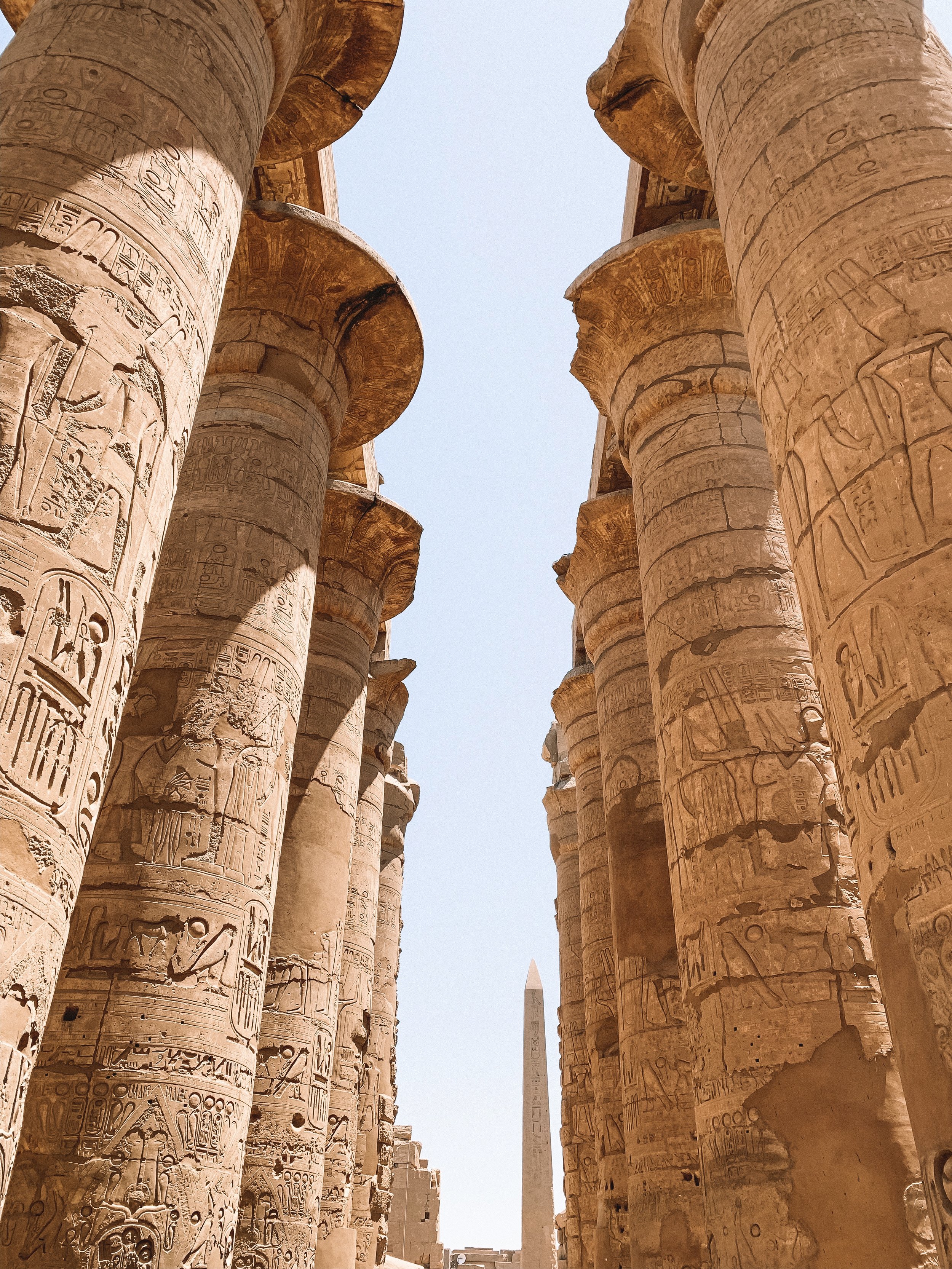


Day 1 – Largely dedicated to the Theban Triad headed by Amun, the magnificent Karnak Temple Complex is the centrepiece of Luxor’s East Bank
This was a day that was the realisation of a lifelong dream.
I will never forget the moment I entered the Great Hypostyle Hall within the Precinct of Amun-Re. You stand, dwarfed, in a forest of stone. 134 papyrus-style columns reach up, some as tall as 24 metres with diameters of three metres.
It was an incredible moment and you wander, your jaw slightly ajar in amazement, through and around the vast space constructed by Seti I and his son Ramesses II marvelling at the vision of these ancient people.
It is so impressive and I implore any visitor to be patient and wait for a moment of solitude (visiting at the right time of day helps) to stand in silence and just look up and around, taking in as much as you can and just appreciating.
But, rewind.
We landed in Luxor from Cairo at 9:10 and headed off with our guide and driver to drop our luggage at our hotel, the Sofitel Winter Palace Luxor. Thankfully our room was ready early and we were able to check-in straight away. This was despite full occupancy due to Egypt’s Prime Minister visiting along with a number of important ministers for World Heritage Day and the unveiling of a restored statue of Ramesses II at Luxor Temple.
Oh, and I ran into Kate Moss and Kim Jones in the lobby.
From the Sofitel, it was a short drive to Karnak. We had our passport photos, copy of passports, Cairo passes and 100 USD each to purchase our Luxor Pass. If you’ve read my Cairo post, you’ll understand that this pass is such great value and if you have the Cairo Pass, the Premium Luxor Pass is offered to you at a reduced rate (50% off the full 200 USD). To show how valuable this pass is, consider that if you want to see the magnificent tombs of Seti I and Nefertari, these are 1,000 EGP (60 USD) each. As these were both on my wish list, I was already ahead.
So Luxor Pass in hand, we were off to explore one of the greatest religious complexes ever constructed.
You approach the complex from the direction of the Nile, a short avenue of ram-headed sphinxes leading you to the First Pylon. In ancient times, the Nile reached close to this point and from a dock, boats would transport sacred statues of the gods to and from the temple for various occasions.
Upon entering the boundaries of the temple proper, you find yourself in the First Court. From this courtyard, you can visit the small, but impressive Shrine of Ramesses III and the Shrine of Seti II. Within in the courtyard are several statues to admire, including a colossal statue of Ramesses II and his daughter.
Your visit will now proceed through the Second Pylon and you enter one of the most impressive spaces you’ll see in your lifetime. Quote me on that. I’ve explained above what this moment is like, but no words or photographs could truly convey its size or beauty. The columns within the hall were built to represent the papyrus swamp from which Amun arose during the period of creation. In fact, the hall was designed to flood during the Nile’s peak in order to emphasise this more.
Be sure to take time to admire the walls of the hall, both inside and outside. There are many detailed depictions to observe from offering scenes between royals and gods, to propaganda scenes telling the stories of Seti I’s various victories over his enemies.
Quick succession through the next three pylons (four, five and six) brings you closer to the inner sanctum of the temple. You will pass the massive obelisk of Hatshepsut, one of a number she erected at Karnak. This incredible obelisk stands 30 meters tall and weighs 323 tonnes. It is a single piece of rock. It’s unfathomable how these people managed to lift this out of the ground in Aswan, move it onto a boat, sail it up the river, take it off a boat, move it into the temple, and then stand it up. How?! Well, Hatshepsut was very proud of all this and recorded the scenes at her temple at Dier el-Bahari, but it’s still unbelievable.
You will now be in the oldest part of the Temple of Amun known today – the Middle Kingdom Court. The Shrine of Arrhidaeus stands here and was built over the original shrine of Thutmose III by the half-brother of Alexander the Great. This would have been where the god ‘lived’ in the form of a statue within the sacred bark and where only the high priest and pharaoh could enter.
From here, we progressed further to the next temple structure – the Akh-menou or Temple of Thutmose III. This is temple has a beautiful and well preserved pillared hall where, in parts, the paint on the columns remains quite vivid. After visiting this area, we turned back towards the main part of the temple and walked past the large Sacred Lake which is 200 m long and 117 m wide.
At this point our guide left us alone to explore ourselves and take photos. From this point, your eyes can follow the direction of the Seventh through Tenth Pylons towards the southern walls of the complex. From this point, the Avenue of Sphinxes picks up again and continues for over 2 km to Luxor Temple. The avenue is currently being restored, and hopefully one day soon you will be able to walk this ancient path.
We passed on the Temple of Khonsu and the Temple of Osiris and Opet this time in favour of heading back to the hotel for lunch and some time by the pool which was well earned after an incredible morning.

















After our break, we headed to the beautiful Temple of Luxor. This temple was significant in ancient times as religious processions would move between it and Karnak Temple along the Avenue of Sphinxes, which starts at the courtyard in front of the temple’s First Pylon.
The First Pylon is decorated with three beautiful statues of Ramesses II, along with one obelisk; the second obelisk which was at the temple is now in Place de la Concorde in Paris. A fourth statue of Ramesses II was restored and unveiled later on this day – we came back for the ceremony which was interesting, but my God, the statue is horrific. It does not fit in at all with the other statues and, to my eyes anyway, looked like a very amateur effort.
The next courtyard – the Great Court – is quite interesting. In this courtyard are actually three religions represented – the Ancient Egyptian temple, the remains of an early Christian church, and the Mosque of Abu Haggag which sits on top of the remains at street level. The courtyard is full of amazing colossal statues of Ramesses II and it’s a nice spot to take a moment.
You then continue through the Colonnade (look out for a beautiful statue of Amenhotep III and his wife), through the Sun Court, through the Hypostyle Hall and into the more sacred areas of the temple. I really liked Luxor Temple – it’s smaller than Karnak, but the well preserved columned areas and long, narrow design of the temple make it easy to take in and explore.
After we were finished looking around Luxor Temple, we had our driver and guide drop us off at Luxor Museum. This is a great place to visit at the end of the day – it’s opening in the evening from 5:00 p.m. and if you come at this time like we did, you can see one of the best collections of Egyptian sculpture in the world with very few people.
My favourite piece in the museum was probably the statue of Thutmose III. The statue is one of the finest examples of Egyptian sculpture. There are also a few statues of Akhenaten which are impressive. A number of statues (in the lower level) were actually found in 1989 when workers were cleaning Luxor Temple – they stumbled across an underground cache of 26 incredible statues in a remarkable state of preservation.
Some tips:
Buy a Premium Luxor Pass ideally after you’ve purchased the Cairo Pass. It’s only 100 USD (down from 200 USD) if you do this. It was great having the pass for our few days in Luxor – we didn’t need to line up anywhere for tickets which was super convenient, and we got amazing value out of the pass. The standard pass doesn’t include the tombs of Seti I and Nefertari, so make sure you get the premium if you want to see these.
Try to visit Karnak either first thing when it opens, or late afternoon. Karnak is swarmed with visitors during the day, especially as people daytrip from the Red Sea resorts. We, unfortunately, arrived around 10:00 a.m. We were going to go on our last morning before we started our cruise; however, we had a few too many drinks and a late night with my friends from London…
We loved having a guide at Karnak – it’s a huge site! Our guide, Mahmoud, was arranged through Deluxe Tours Egypt and he was SO much better than our Cairo guide. He was great at showing us some key highlights, and then gave us as long as we wanted to explore on our own and take photos.
Get your hands on a book called The Treasures of Luxor and the Valley of the Kings by Kent Weeks. This is a fantastic resource and really gave us such great knowledge of everything around the Luxor area. I read about all the places we wanted to visit before I left Australia and it was great to be able to refer back to it.
Visit Luxor Museum in the evening. It’s a nice place to spend an hour (you don’t need any more time than this).
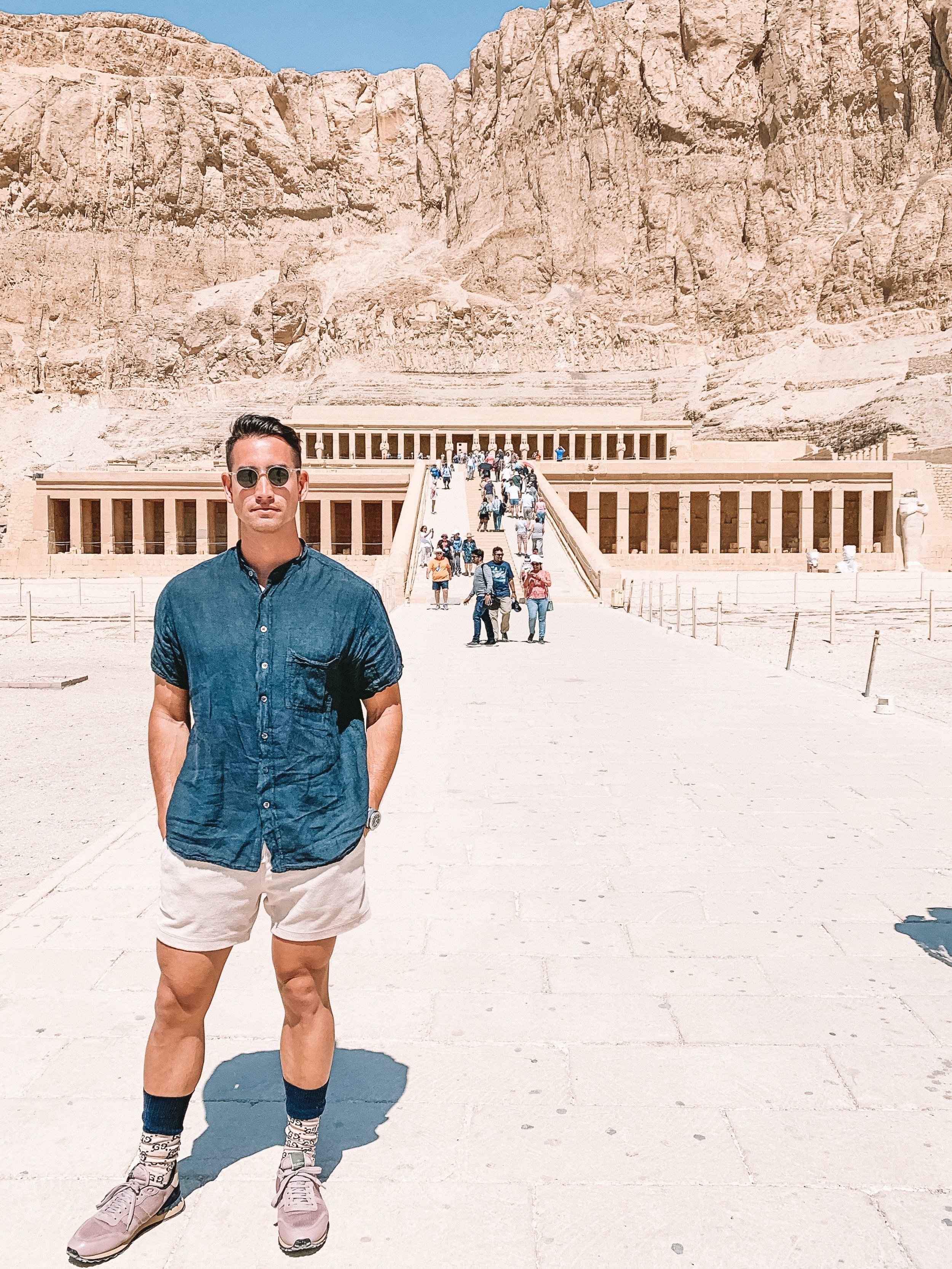






Day 2 – An incredible day exploring the Ancient Egyptian obsession with the cycle of life capped off with galloping beautiful Arabian horses past the Temple of Hatshepsut at sunset
This day was the first of two that we dedicated to seeing as much as we could on Luxor’s West Bank, of which the main focus is Theban Necropolis and its many attractions which have long drawn travellers to Egypt, and have captivated many more around the world.
The West Bank is literally littered with ancient sites – ranging from the many mortuary temples, the most famous being the stunning tiered Temple of Hatshepsut, to the Valley of the Kings, home of Tutankhamun’s tomb whose treasures were was discovered in 1922.
Our first stop after a long drive from our hotel on the East Bank was Deir el-Bahari, home to the Temple of Hatshepsut. This temple is a masterpiece. There isn’t really any other way to put it! The moment you first see it (ideally in morning life) at the base of the cliffs, it’s low, wide terraces cascading into the rock behind it really is breathtaking.
The lower terrace has some interesting reliefs which a visitor should see, particularly the south side which details how Hatshepsut’s architects and engineers moved two obelisks from Aswan to Thebes. I mentioned this depiction in my day one notes above – one of the obelisks still stands proudly at Karnak.
Ascending the ramp, the middle terrace also has a number of interesting reliefs. As in many temples, there is the story of the Queen’s divine birth which unfortunately was defaced by her successor Thutmose III who tried very hard to erase his stepmother from history. There is also a small shrine to the goddess Hathor on this level with many beautifully preserved Hathor columns and a brightly painted chapel.
One of my favourite reliefs I saw in all of Egypt was also on the middle terrace – the depictions of the Hatshepsut’s expedition to Punt (most likely modern day Somalia). The reliefs of daily life in this foreign land are amazing, especially the different plants and animals that would have been very foreign to the visiting Egyptians along with images of goods being transported back to Egypt.
Oh, I also stalked Kate Moss and Kim Jones on this terrace for a bit.
The upper terrace was the most important area of the temple and is architecturally beautiful. There are a few interesting spots to view such as the courtyard dedicated to the solar cult of Ra-Horakhty, along with the most holy royal shrines accessible through the columns and huge granite doorway.
Our next stop was just south of Deir el-Bahari at the location of many of the Tombs of Nobles. We saw two tombs here – the small Tomb of Sennefer and the unfinished Tomb of Ramose. Sennefer was an important official in his time and his vividly decorated tomb is one of the finest non-royal tombs in the necropolis, most famous for its ceiling which is covered in images of vines.
The Tomb of Ramose is large and very much reflective of his important role and wealth in Theban society at the time. The vast columned first chamber is the only chamber you can visit, but it is well worth it to see the fascinating reliefs on the walls. These were some of the finest and most detailed reliefs we saw in all of Egypt showing interesting funerary rituals and Ramose’s relationship with the Amenhetep IV, later known as Akhenaten.
Next up was the Valley of the Kings which is only a short drive from where the Tombs of Nobles are. This place is just incredible! It’s hard to fathom how the Egyptians did what they did here – one of the tombs is cut over 200 m into the rock, and the decoration is beyond.
We saw five tombs on the day (Seti I, Ramesses V & VI, Ramesses IV, Ramesses III, and, of course, Tutankhamun. The usual ticket allows three, and the tombs of Seti I and Tutankhamun are extra. With the Luxor Pass however, you can go to as many tombs as you want! I probably would have gone into them all if I had time… Next time. Keep in mind, they cycle through which tombs are open to the public, so if you have a list, it needs to be a bit flexible.




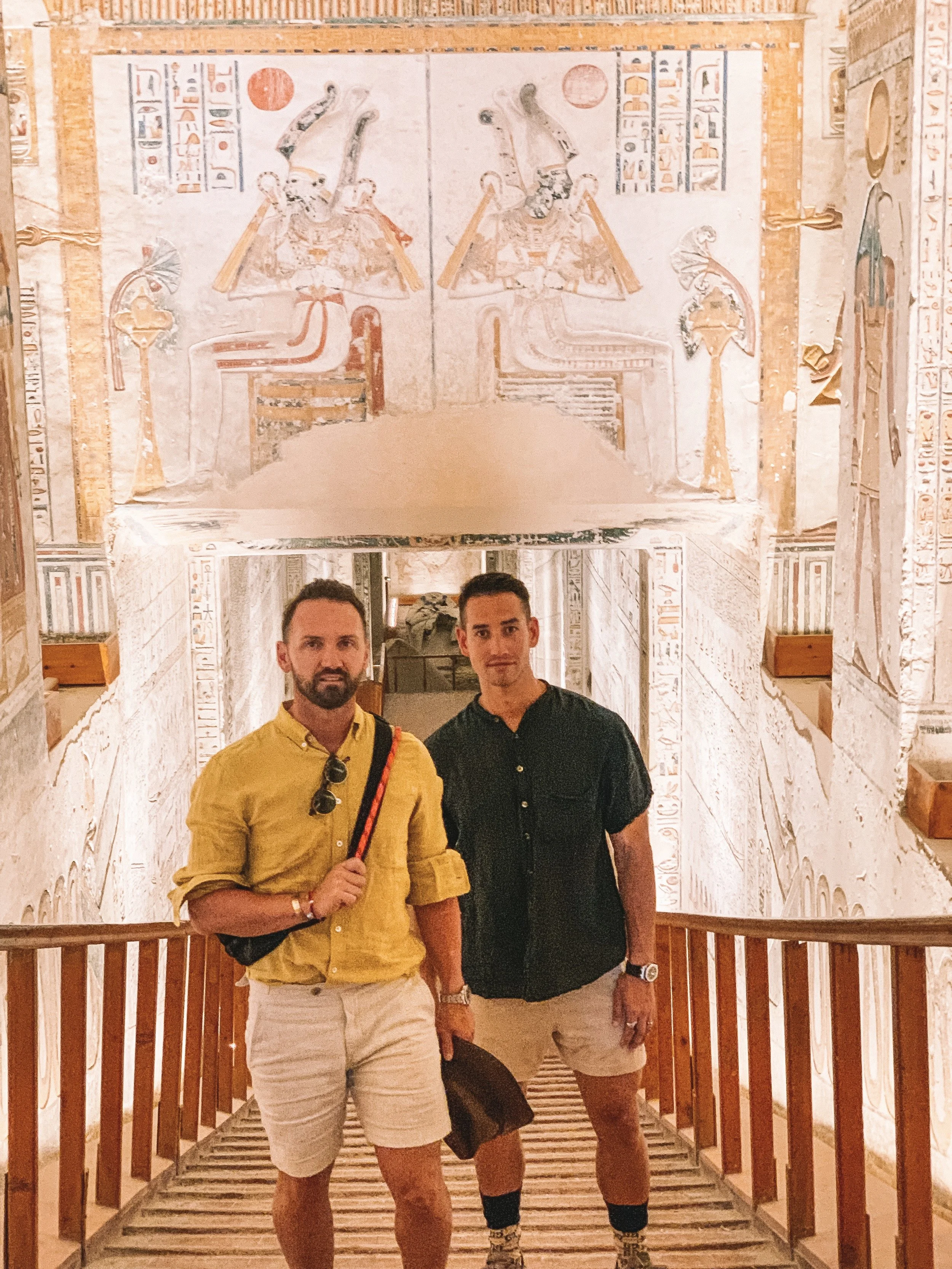






To be honest, it’s hard for me to pick a favourite tomb. If I had to choose it would probably be between the Tomb of Seti I and the Tomb of Ramesses V & VI. I think for me I expected more from the Tomb of Seti I – I’m not really sure why. Perhaps it has something to do with the tomb being an extra 1,000 EGP (60 USD) ticket on top of the regular entry fee (we didn’t need to pay this with our Premium Luxor Pass). Don’t get me wrong, it is super impressive and the ceiling of the burial chamber will blow you away! I was really impressed by the scale and level of artistry though, and can absolutely appreciate why it’s many people’s favourite tomb.
I really loved the Tomb of Ramesses V & VI. It’s a long tom at just less than 120 m and is unusual as two kings were buried here. Ramesses V started the tomb during his reign, and then it was usurped by his successor. I liked the simple layout of the tomb – it is essentially just a straight axis with an impressive four pillared chamber at the midpoint and a spectacular burial chamber with a really incredibly painted ceiling. It was quite atmospheric here with the sarcophagus and the cracked granite lid remaining. I don’t think we’re allowed photos in here, but the guy told us to go over the barrier and we got some nice photos of the ceiling.
Of the other two Ramesside tombs we saw, Ramesses III is super long – the second longest in the valley actually at 188 m. The Tomb of Ramesses IV was more interesting – it has a beautiful burial chamber with the huge sarcophagus still in place. I really have no idea how they managed to drag these things into these tombs. And then load them up with coffins... It’s really amazing to comprehend they did all this.
The final tomb we saw was the Tutankhamun’s. This is actually the smallest tomb in the Valley of the Kings, but of course, is the most famous given the unimaginable treasures which were discovered here in 1922 by Howard Carter. The highlight is the burial chamber which, whilst not as elaborate as others contains the beautiful red quartzite sarcophagus with Tut’s gilded outer coffin still inside. The second gilded coffin and the inner sold gold coffin are at the Egyptian Museum in Cairo.
What I wasn’t expecting was Tut’s mummy to be on display in the antechamber. We felt a bit strange about this – it hadn’t dawned on me until this moment that actual people were buried in here and they really didn’t want to be found or disturbed so they could live in their next life. Now we traipse in and out of their resting places, looking around, taking photos, being noisy, and, in this case, straight past a royal corpse that was laid to rest here 3,350 years ago.
After the Valley of the Kings, we stopped for lunch at the Marsam Hotel which is the oldest hotel on the West Bank. I would really recommend lunch here. The food was really delicious and plentiful, and the setting in the courtyard next to the green fields was very atmospheric and a nice shady respite from a hot day exploring.
Our final attraction on our list for the day was the Mortuary Temple of Seti I. The temple is quite small and appears to sit quite low and flat. I was reminded of its architecture when I visited Abydos a couple of days later and saw Seti’s temple there. The temple is quite well preserved – the stone sections at least; mudbrick construction has been washed away over time – and there are interesting shrines to the Theban Triad (Amen, Mut and Khonsu), as well as a chapel for Seti’s father Ramesses I. It’s nice to see images of three generations represented in the temple.
After we had finished viewing the temple, we headed to our sunset horse riding which started at 4:00 pm. I arranged this through Luxor Stables when I arrived the day before. It was super cheap – 300 EGP (less than 20 USD) each for the three hour ride, plus tips for the guy who took us out. I was a little worried about what the horses would be like, but as soon as I saw the three beautiful Arabian horses, I knew these fears were unfounded.
The owner of the stables, Nobi, was a really nice guy and looked after as well. We were provided with good quality riding helmets and chaps for our lower legs. The guy who took us out for our ride was also great and seemed keen to help us improve our riding. I’m probably intermediate level and I’d only galloped on a horse once before when on safari in South Africa.
We really loved this activity and were so glad we decided to do it. It was great walking and trotting through villages and farms and a good insight into local life in this part of Egypt – the kids are so cute! We went past various temples and monuments during our ride as well as into the desert. The highlight was definitely galloping as the sunset with the Temple of Hatshepsut alongside us.
The memories of this ride will stay with me forever. Seriously, if you love horses, no matter what your level of experience, I’d really recommend doing this. The horses were beautiful and I felt so comfortable and confident with my mare the entire time.
After our ride we took a short walk from the stables to the docks on the east side of the river. It was a quick trip on one of the motored boats directly across to our hotel and the end of a really great day.
Some tips:
Even though we split our time on the West Bank across two days, this was still a long day. Start early – it gets super hot in summer.
Plan your visit – there is a lot to see and scheduling can be advantageous to manage time and to make sure you avoid crowds, for example, we arrived at the Valley of the Kings very late in the morning when most would have already visited and had left to go find lunch.
Have lunch at the Marsam Hotel. The food is great and I thought it was pretty inexpensive for what we had. The location is also really relaxing and a nice way to spend an hour or so in the middle of the day.
Have a good guide book with you – guides are not allowed with you in the tombs and it isn’t worth listening to or tipping the guardians for information. I used The Treasures of Luxor and the Valley of the Kings by Kent Weeks.
In every tomb, the guardians will try and get money out of you anyway they can. It is completely up to you whether you engage with them or if you want to break the rules and take photos when you’re not supposed to. We paid them off mostly with 20 EGP notes we had, they seemed a bit annoyed with it, but we didn’t want to overly reward their technically bad behaviour…
Make sure you have a photo pass for the tombs if you want to take photos (some tombs you technically aren’t allowed to take photos, but everyone has a price). These are 300 EGP (around 18 USD)/. If you don’t you have to pay up to the guardian, or delete the pics.
If you have a driver, try and get them to meet you across the river. If you’re staying on the East Bank as we were, it would be so much easier to just get one of the many boats available back and forth each day rather than wasting time driving for around 40 minutes just to cross the bridge. We paid 60 EGP (under 4 USD) following our horse ride to get back across the Nile.












Day 3 – A second day on Luxor’s West Bank filled with more incredible tombs and temples
Our next day was again dedicated to Luxor’s West Bank. Contrary to my tip above about saving time and getting a boat straight across the river, our driver picked us up from the hotel after breakfast and around the world we went to get across the bridge and to our first stop.
But wow, what a stop.
Madinat Habu sits at the southern end of the Theban Necropolis and has a number of monuments, the most impressive and main reason for visiting (albeit, barely any other tourists were there) being the Mortuary Temple of Ramesses III, whose tomb we had seen the previous day.
The temple is in an incredible state of preservation – one of the best in Egypt – which is amazing given it has been standing for some 3,200 years. The temple has some fascinating scenes which are amazing carved into the walls – some hieroglyphs are that deep you can fit your whole hand into the space – and the temple retains a significant amount of original paint showing how bright and vividly coloured the Ancient Egyptian temples must have been.
A number of the most interesting scenes are focussed on Ramesses III’s victories over his enemies. The large first pylon has a huge image of Ramesses with his enemies before Ra-Horakhty. These are some of my favourite images of the kings – they look so powerful in their stance, one hand holding their enemies by the hair and the other hand a weapon ready to strike them into submission.
The First Court has one of my favourite tales of victory in Egypt – you can see the aftermath of a battle against the Libyans where the hands of enemies are cut off and presented to the king. As sometimes it was possible to get dead Egyptian hands mixed up with those of their dead enemies, the Egyptians also used to cut off the penises of their enemies to collect. Circumcision was the norm in Ancient Egypt whereas most enemies did not practise this. There are also some amazing images of Ramesses defeating the Sea Peoples.
As we moved through the temple, we started to recognise elements of construction that were common to most temples. Courtyards, hypostyle halls, columns here there and everywhere. The second court of this temple is very beautiful – the colours here are so well preserved and it really doesn’t take much imagine to think what it would have been like back in the day.
Unfortunately the vast hypostyle hall does not have any columns left (only the bases remain), but you can still see what an incredible space this would have been, particularly if you have already been to Karnak.
There are some nice statues dotted around the temple – in varies conditions. My favourite was a granite statue of the goddess Sekhmet who is depicted as a lioness. She was an important goddess and represented sun, war, destruction, plagues and healing. Fitting she is featured here given how Ramesses III seemed to be such a great warrior himself.
Our next stop was the Valley of the Queens. We arrived mid-morning, and like Madinat Habu, there was barely anyone there. Like the Valley of the Kings, you purchase a ticket for a number of tombs, and if you want to see the main attraction, the Tomb of Nefertari, you pay an extra 1,000 EGP (just under 60 USD). Again, we had our Luxor Pass (premium version), so we could see whatever we liked. We just saw three tombs here – Nefertari, Khaemwaset and Tyti.
First up was the Tomb of Nefertari. She was one of the most revered women in Ancient Egypt as the Great Royal Wife of Ramesses II. She even has her own great temple at Abu Simbel which we would see later in our trip. The tomb is spectacular. You’re only supposed to be inside for 10 minutes; however, we were apparently special and were granted an extra five minutes. You’re also in there on your own (I think? Or we might have been lucky?).
The tomb is much smaller than most of the royal tombs we had seen previously – obviously the queen was not Pharaoh. It largely consists of two beautifully painted main rooms (the antechamber and burial chamber), some side chambers, and the halls or ramps. The colours are so vivid against the white backgrounds, and throughout the tomb, you can tell from the images of Nefertari, that she was as beautiful as the stories of her claim her to be.
Whilst the tomb is spectacular, I do feel that it is slightly over restored – it underwent a major conservation project in the late 80s and early 90s. The plaster walls covering the rock are super delicate and fears for the safety of the tomb have forced it to be closed at various times so work can take place to preserve it. As the plaster is placed straight onto the rock, changes in the air inside from sweaty tourists are causing the plaster to buckle. They think they have slowed it, but the plaster could still fall away. Apparently they are scanning and taking images of the tomb to create an exact replica, and then the tomb will be closed forever. So, if you want to see it, I suggest you go as soon as possible.
One last thing about this tomb, apparently there is a strict no photo rule here. But, like I said in my tips above, everyone seems to have a price. The guardians (two of them) seemed super keen for us to take photos, but they were asking kinda crazy money and, to be honest, we just had our iPhones which weren’t going to take amazing photos anyway. Plus I did feel a bit guilty and bad each time I encouraged bad behaviour in the tombs…
Next up was the Tomb of Khaemwaset, a son of Ramesses III (and possibly Queen Tyti whose tomb we saw next). The tomb has some nice images throughout it and you can see numerous decorations of the prince’s father presenting his deceased son to the gods. Quite a few of the scenes show Ramesses III walking in front of his son – you can tell the difference as Khaemwaset is depicted as a young boy with the his hair in the sidelock style and his father is obviously shown as the adult king with the regalia that comes with that.
The final tomb we saw was that of Queen Tyti. This tomb was also small and quite simple – basically just a cross layout – but had some well-preserved scenes which are very similar to those featured in Khaemwaset’s tomb. The weirdest thing in here though was the guardian. As they all do, they start trying to point things out, then they start moving barriers and ushering you into supposedly closed areas of the tomb.
However, this guy showed us something so strange and kinda wigged us out. He took us into the antechamber to the left of the burial chamber and held his finger up and made a ‘shhhhh’ sound and said: “No tell.” We were like wtf, but okay. Next thing, he bends down and moves a wooden board from the floor and a hole is revealed. Then he motions for me to give him my phone and he turns on the torch. He shines it into the hole and then points for us to look. There was a damn mummy just lying in the hole (surrounded by rubbish of course…).
It was such a strange moment and I felt like I just had to get out of the tomb and leave that poor woman in peace. I’m not sure if it is the mummy of the queen; my book doesn’t mention the mummy, just that the hole in the antechamber leads to a burial chamber. It was just an odd moment and feeling – it reinforced how I felt being in the Mummy Room at the Egyptian Museum, or in Tutankhamun’s tomb the previous day.
After this, we went for a quick stop at Deir el-Medina for a walk around the artisan’s village and to see a tomb I had read about. To be honest, we probably didn’t spend as much time here as we should have so I don’t have a lot to say other than it was interesting seeing the well-planned village where the artisans who worked on the royal tombs lived. Apparently generations of families would live and die in the village, kept from the outside world in order to guard the secrets of the tombs they helped construct or decorate.
We saw two tombs here – the Tomb of Sennedjem and the Tomb of Inherkhau. The tombs of the workers from the village are quite special as they are beautifully preserved and some of the best work you will see given that the workers themselves worked on royal tombs. Also unique is that they depict images from the Book of the Dead, which up to this time, was restricted to royal tombs.
Almost absent from the tombs are scenes of daily life and family life which were common in non-royal tombs, although there is a beautiful image of this in Inherkhau’s tomb. They are small, cramped spaces, but the beautiful paintings on the bright yellow backgrounds are well worth seeing. We probably should have seen the Tomb of Pashedu whilst we were in the village, but I didn’t read about it until after the fact (and our guide didn’t mention it…).



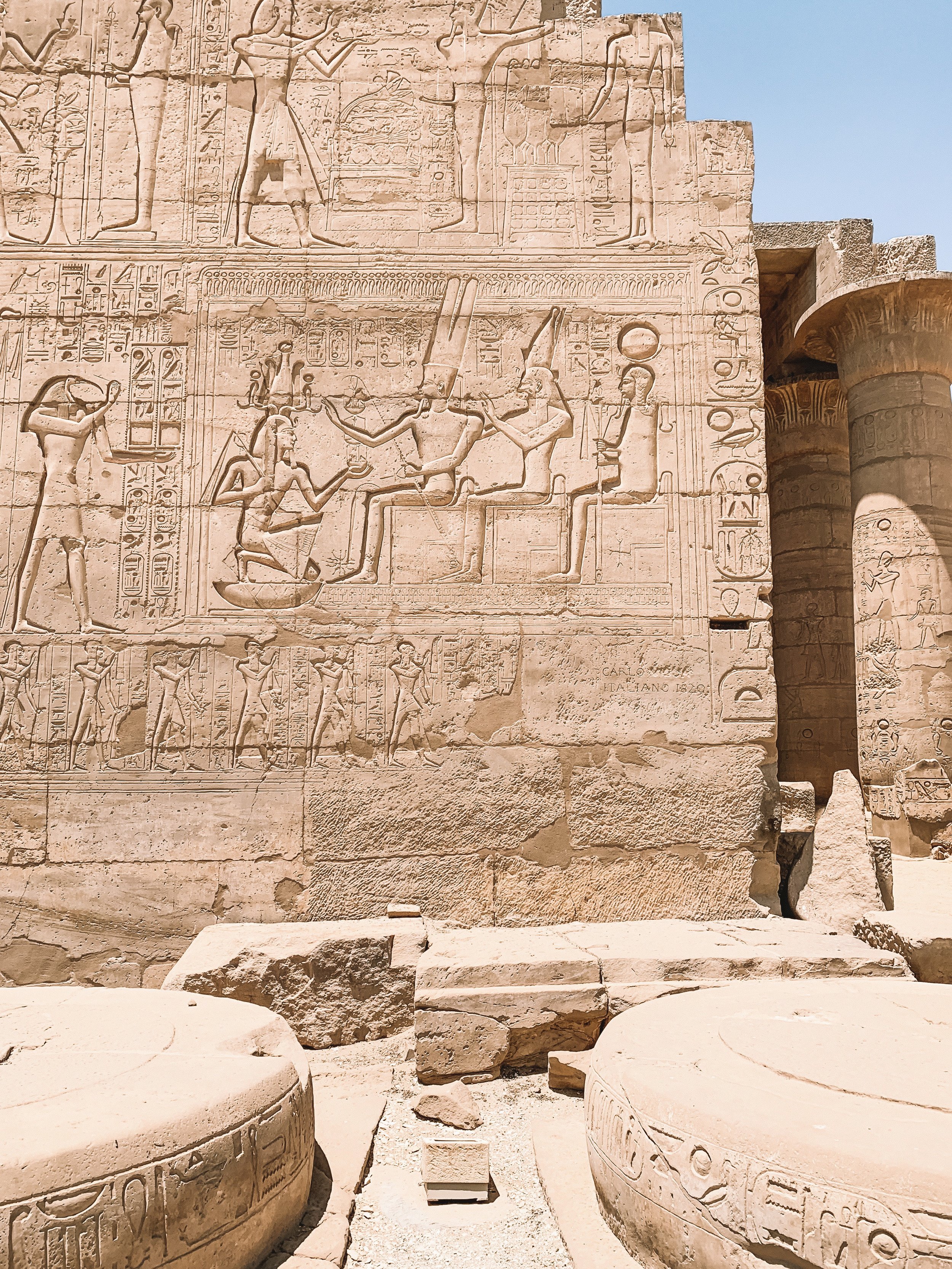


I met a traveller from an antique land
Who said: "Two vast and trunkless legs of stone
Stand in the desert . . . Near them, on the sand,
Half sunk, a shattered visage lies, whose frown,
And wrinkled lip, and sneer of cold command,
Tell that its sculptor well those passions read
Which yet survive, stamped on these lifeless things,
The hand that mocked them, and the heart that fed:
And on the pedestal these words appear:
'My name is Ozymandias, king of kings:
Look on my works, ye Mighty, and despair!'
Nothing beside remains. Round the decay
Of that colossal wreck, boundless and bare
The lone and level sands stretch far away."
- Shelley, P. Ozymandias.
Our last major location for the day was the Ramesseum, the Mortuary Temple of Ramesses II, known to some as the Tomb of Ozymandias which inspired a famous poem.
The first court is where you will see the famous colossal statue of Ramesses II. This incredible statue of the king seated is still the largest monolithic statue ever sculpted. Now collapsed, when it was complete, it would have been 17.5 m tall and weighed over 1,000 tonnes. This was one single piece of granite. It’s really unbelievable the scale of the statue – one of the ears of the fallen head measures almost a metre long.
As is common at a lot of monuments erected by Ramesses II, you will see many references to his infamous military campaign against the Hittites, specifically the Battle of Kadesh. Look out for these as you pass the first pylon into the first court.
The temple isn’t the best condition, but it is still great to see given the scale of some of the statues. The second court has some great statues remaining (a lot of this is ruined though). The other highlight is the hypostyle hall where some of the columns still retain some beautiful original colour and you can see some interesting images of Ramesses in military campaigns and of some of his sons – this guy lived so long he had around 50 sons and 40 to 50 daughters. He lived so long that 12 sons passed away during his reign leaving the 13th, Merneptah, to succeed him.
After we’d finished viewing the temple and some of the outbuildings (mostly ruined storage areas, some skeletons, and the palace), we headed back to Luxor via a quick photo stop at the Colossi on Memnon which we’d already been past a couple of times and saw on when horse riding the day before. We got back to our hotel in time for a late lunch and relax by the pool, which was great and much needed after a couple of full on days.
We ventured out late afternoon to go and have a look at the festivities around the Mosque of Abu al-Haggag. It was a special weekend in Luxor as it was also the Moulid of Abu al-Haggag which is basically a five-day carnival honouring the 13th century leader whom the mosque is named after. The party looked pretty crazy – there were loud music trucks with men dancing and following them around.
This was where I had my only really negative experience with a local (aside from the guide in Cairo…). I was walking along watching what was going on and this kid (a teenager I assume) came up to us demanding something. I could tell he was pretty excited by all the commotion and he was obviously a bit of a thug kid walking around with no shirt on thinking he was tough.
Anyway, he came really close to me and I stared him off and spoke really bluntly to him telling him to go away. This completely seemed to enrage him and he came at me with a metal pipe and swung it at a metal railing right near my head. I don’t know if he intended to hit me or just scare me, but it was all a bit crazy and really frightened me. I’m a big guy – 185 cm, 92 kg, but this angry little kid with a metal pipe was definitely not worth getting involved in anything with. An older local went agro at the kid and we retreated into the souk and made our way back to the hotel. This was literally the only time I momentarily felt unsafe during our two weeks in Egypt, which is a shame. Obviously the kid hasn’t learnt yet that tourism keeps his city alive.
Some tips:
Pretty much the same as previous days – get a good book to help bring to life what you’re looking at, and if you’re in Luxor for a few days, the Premium Luxor Pass is worth the money.
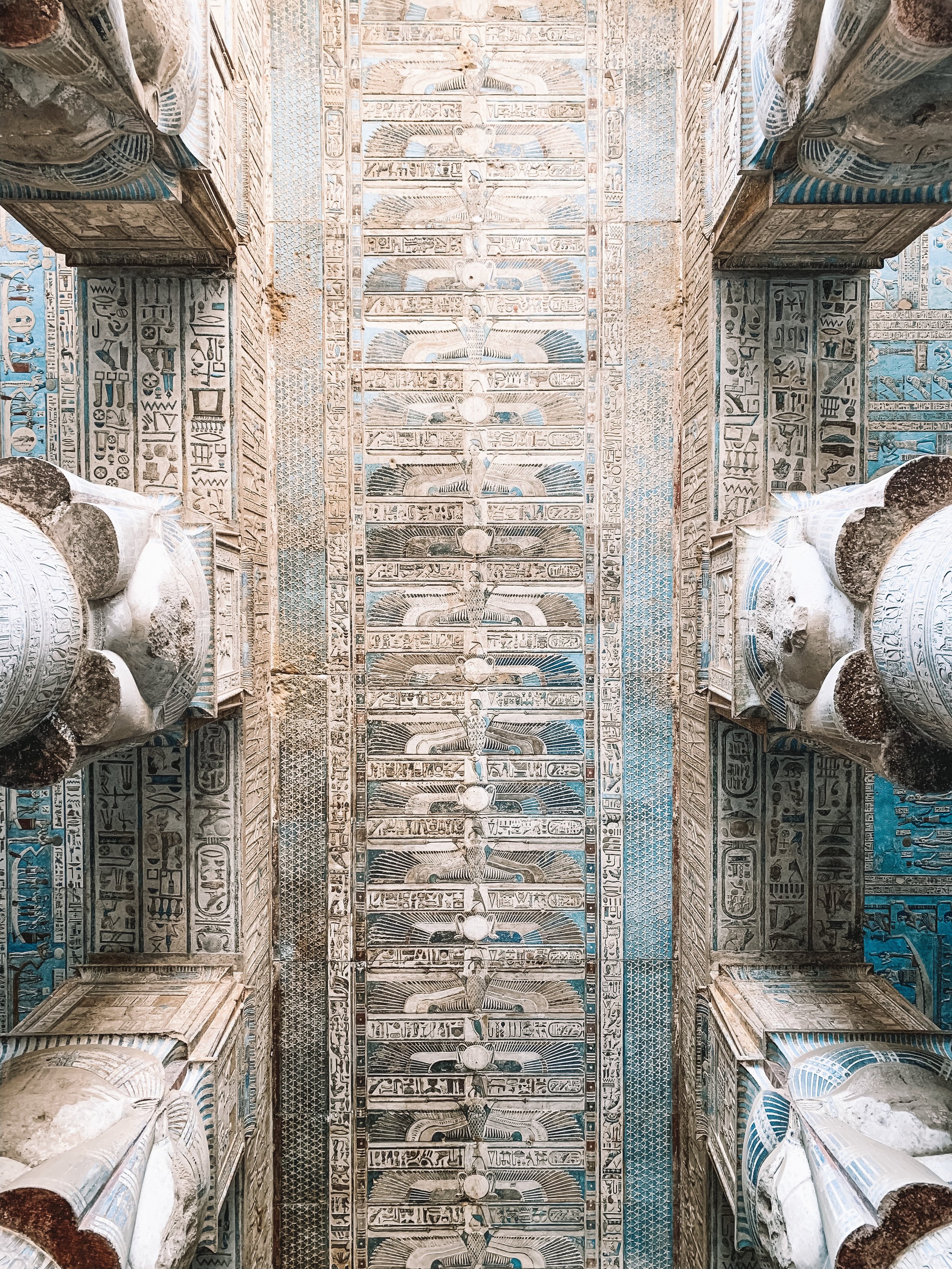
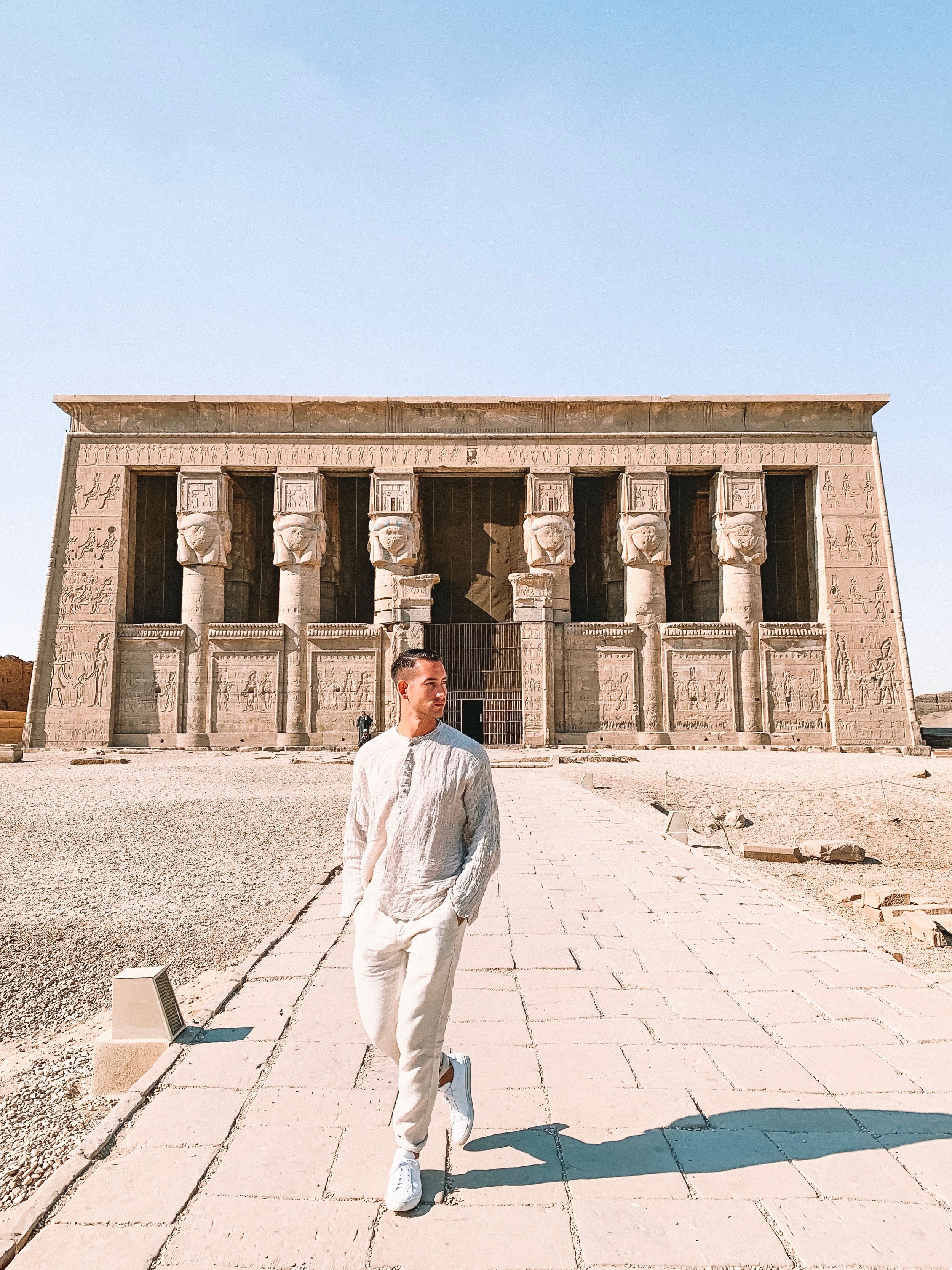
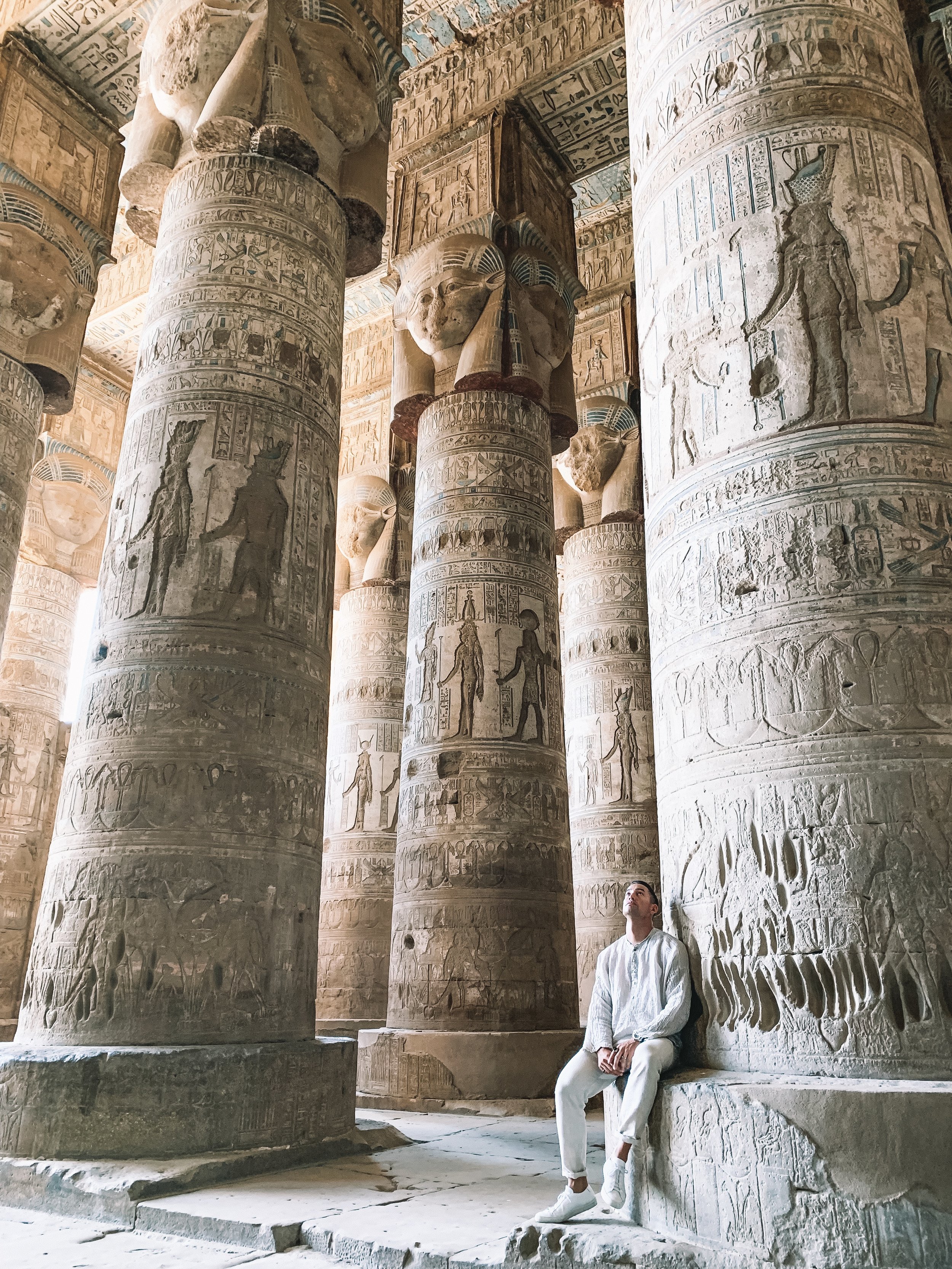





Day 4 – Is it a helicopter? Is it a submarine? Is it a fighter jet? Is it a boat? The mysteries of Abydos…
This was a long day…
We were picked up by our driver and guide around 5:30 a.m., takeaway lunchboxes from the Sofitel in hand, for the long drive north to the Dendera Temple complex and Abydos. The drive to our first stop Dendera was around a two hour drive, from there to Abydos should have been around 90 minutes, but I think our driver took a wrong turn and we ended up taking about two hours. And then back to the hotel was another 2.5 hours. So if you’re keen to see these two sites, and you should be, plan on spending six hours in a car and try and make sure it is a comfortable one.
From Luxor to Dendera you follow the Nile on the west side passing through various towns and villages along the way. I hate the roads in Egypt solely for the amount of apparently pointless speed bumps they have on the roads – and these things are sometimes huge – requiring constant slowing down. It’s only 76 km to Dendera, but do not be deceived by this – it takes ages.
We arrived at the temple just before 7:30 a.m. and I think we might have been the first people there. This temple was the first Ptolemaic monument we saw in Egypt. The Hellenistic Ptolemies ruled Egypt after Alexander the Great from around 300 BC until the death of the famous Cleopatra VII in 30 BC.
The Temple of Hathor was mostly constructed during the reign of the queen, and you can see fine reliefs of her on the rear outer walls of the temple. The picturesque approach to the temple takes you past small Roman and Coptic monuments until you arrive in the forecourt and can admire the grand façade of the temple, with the faces of the six Hathor columns seemingly looking down at you.
The vestibule is the first room you enter and is much more impressive than the subsequent hypostyle hall. 18 stunning Hathor columns occupy the space and the temple is so well preserved, you almost feel like you’ve gone back in time. The blue in here is so incredibly vivid – I especially loved the scene on the roof depicting the zodiac.
There are various other interesting chambers around the ground floor of the temple. Be sure to go down into one of the crypts – the carvings in these rooms are amazing. It’s also important to visit the second level of the temple. Here you will find a beautiful carving of the zodiac – well, a replica of the original at least. The original was removed and carted off the Louvre in Paris in the 1800s.
After we finished looking around the temple, we set off for Abydos. This was all a bit of a commotion… The guards didn’t want us to leave on our own and wanted us to wait until a tour bus that had just arrived was ready to leave so they could escort us all together. After a lot of to-and-froing, we were finally allowed to leave with just one other car. As we were going to Abydos via the desert road, we had to have a police escort with us. I don’t really get why, apparently it’s completely safe but it’s just the rule, but they sped along with us for about 45 minutes and then randomly stopped and went away.
Our driver turned off the highway at some point and we ended up in the middle of this random small town. Well, this place I don’t think had seen a foreign person ever. We’d obviously made a wrong turn (our driver kept asking for directions), but I was kind of glad we did. We got to see some local life we wouldn’t have seen otherwise and I actually really enjoyed driving through the village – the women in their billowing burqas, the young kids on their donkeys, people selling stuff everywhere…
We finally made it back onto the right road and we arrived behind a bus at a checkpoint on the way the Abydos site. This is one of my most favourite moments of my trip. We were waiting out of the car for whatever was supposed to happen to happen (who really knows what’s going on in these places half the time) and I saw my friend’s husband from London! He was on the bus in front of us. He went onto the bus and got Nicola and we had a massive reunion hug (it’d been about five years I think) on the side of the dusty road while all the police and military watched as. I knew she was in Luxor and heading to Abydos too on this day, but it was such a great and random moment to run into her in the middle of nowhere.
Anyway, we finally got cleared to go through the checkpoint and off we went to Abydos with our police escort and their big guns.



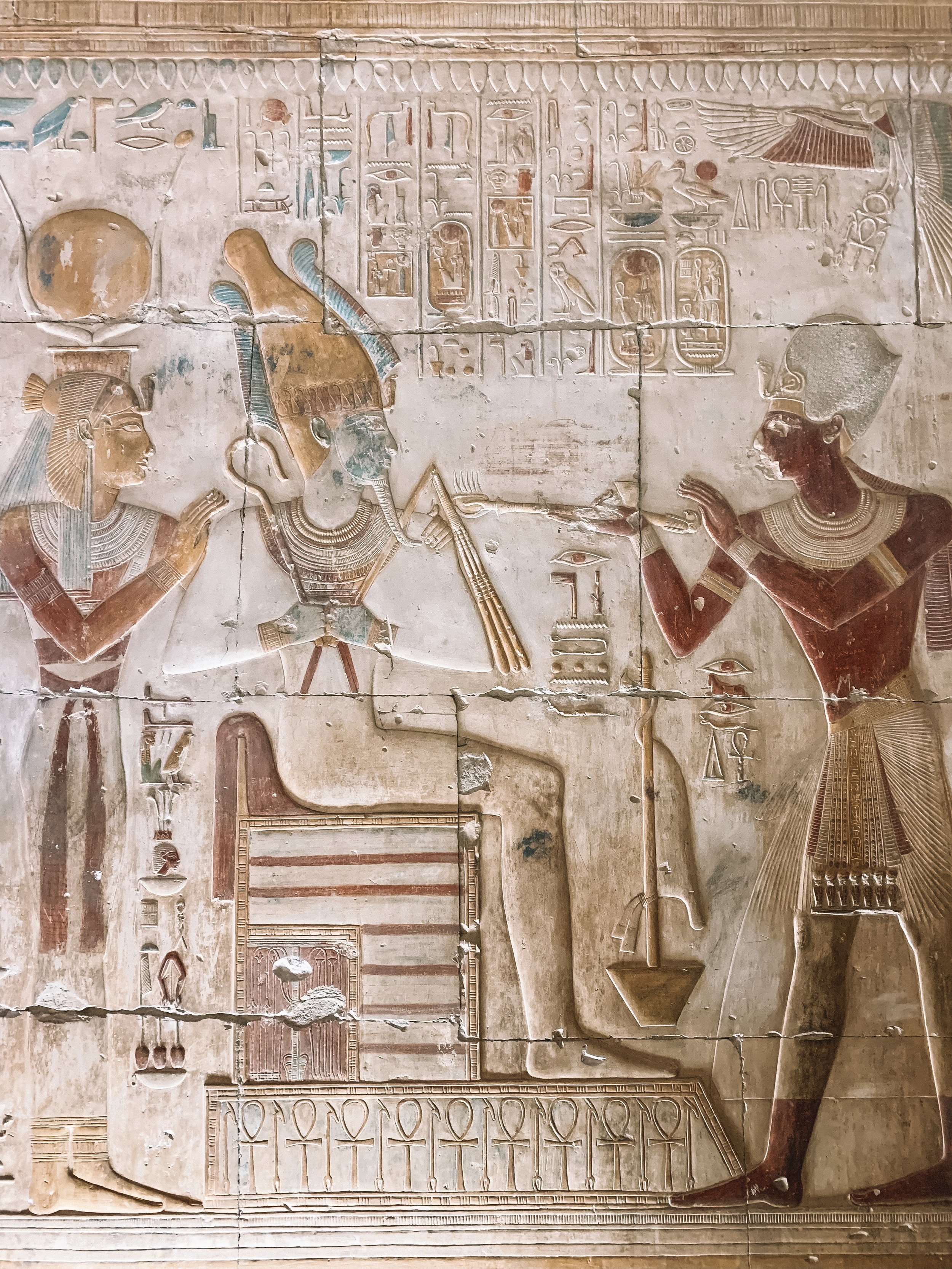


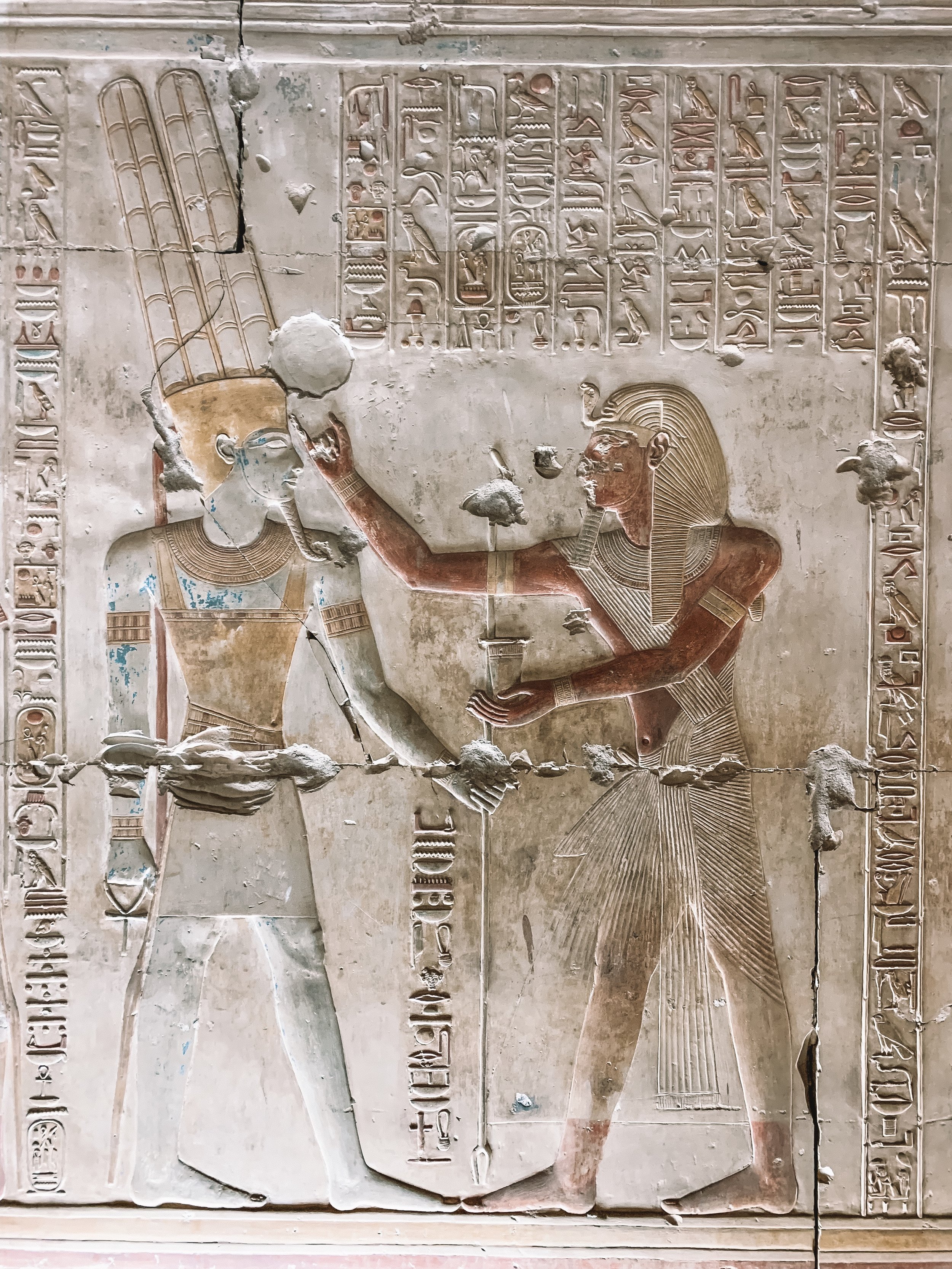



The Temple of Seti I at Abydos is extraordinarily well preserved. It is a stunning temple and certainly worth the drive from Luxor to see it. The temple, begun by Seti I and completed by his son Ramesses II, is thought of as one of the masterpieces of Egyptian art and architecture and it is easy to see why as you explore the temple.
The first hypostyle hall is grand with 24 beautifully carved and decorated columns. There are many beautifully depicted scenes around this room. One of the most interesting things to see though is the infamous hieroglyphics that look like (depending on who you ask) a helicopter, a submarine (or a boat) and a fighter jet. It’s kind of crazy looking at these! The plausible (and accepted) explanation is that original hieroglyphs were plastered over and new ones were carved. As time went on, some of the plaster fell away and left thee weird ‘new’ hieroglyphs which actually don’t mean anything. This may well be the case, but I kind of prefer the other theory – what’s life without a little drama and intrigue?
The next room is the second hypostyle hall. This room is not as large as the first hall, but the carvings on the walls in here are spectacular. These carvings are so well done – probably the best of any we saw in Egypt. The detail is incredible – especially the clothes and hair of the people.
Off this room are seven chapels dedicated to various gods – Horus, Isis, Osiris, Amen-Ra, Ra-Horakhty, Ptah and Seti I. The best is the Osiris chapel which has a doorway (instead of a false door for the spirit of the god to come and go) through to another columned room with three small chapels for Horus, Seti I and Isis. The detail in all these chapels is incredible and lots of the original colour is well preserved. The scenes are all pretty similar (offerings, rituals), but it’s worth taking a moment to check out each one.
The next most interesting room to see contains probably the most famous carving at Abydos. The Hall of Ancestors is also known as the Gallery of the Lists and contains the Abydos Kings List. You see king Seti I with his son Ramesses II before the list which has the names of all (well, most) their ancestors, 76 in total going back to Menes, the first king who ruled Egypt some 2,000 years before Seti I. I find it so crazy that the Ancient Egyptians already had an ancient history of their own! The list does omit some kings though who were deemed illegitimate, too minor, some females (such as Hatshepsut), or from the Armana period (specifically Akhenaten, Tutankhamun and Ay).
Outside of the main temple at Abydos you can visit the Osireion which was believed to be the burial site of Osiris. It’s designed like a tomb and descends down quite deep (groundwater is visible). You can’t access the site, but you can view from above.
A short walk away (it was a nice moment walking on our own with the sound of the call to prayer coming from the village) through rocks and dirt, you will find the small and mostly ruined Temple of Ramesses II. Most people would skip this, however, ever since I read Christian Jacq’s ‘Ramses Series’ , I’ve been obsessed with Seti I and Ramesses II so had to visit this temple. There isn’t a lot to see here, but it is atmospheric and there are some lovely painted reliefs.
Once we had finished up after spending some time wandering on our own and taking a few more photos, we headed off on the long trip back to Luxor. For whatever reason we managed to escape without needing a police escort this time, however, when we reached the final checkpoint near Luxor on the West Bank (we took the desert road the whole way this time, thankfully), the driver pulled over and put window covers up so people couldn’t see us in the back.
Apparently, at the next and final check point, if they see foreigners in the car, they make them pay a fee (they prefer foreigners to use the Nile road for the last bit). This was so dodgy and we felt super anxious heading towards the check point. I kept thinking what would happen if they stopped us or saw us through the windscreen?! Anyway, nothing eventuated and we were just waved through. I asked what the fee would have been and it was something like 150 EGP. That’s like 10 USD. Seriously, I would have just rather pay the fee and be done with it!
We saw a horrific car accident along the highway too. Make sure you wear seatbelts as people drive very, very fast along this road. The car must’ve driven off the road somehow – I assume lost control – and had crashed into a ditch and was completely in huge flames with billowing black smoke.
Our driver dropped us off on the West Bank near the dock where we could quickly hop over to the Winter Palace. We said our goodbyes to our guide Mahmoud who we’d really enjoyed having with us for the last four days and headed to the terrace of the hotel to enjoy some drinks and our last beautiful Luxor sunset.
My friends came over to our hotel when they got back from Dendera and we had a great night at the hotel regaling each other with stories of our travels through Egypt. I can imagine how Lord Carnarvon and Howard Carter would have sat in the bar of the hotel in the early 1900s discussing their many excavations on the West Bank.
Some tips:
This is a long day. Be prepared to sit in the car for long periods.
Bring a packed lunch from your hotel. The Sofitel gave us a great spread which kept us fed for most of the day. We did get some snacks at a shop near Abydos though. There was a restaurant on the side of the road right near Abydos that our driver and guide had lunch at, but it looked a bit local for me. A big French tour group rocked up for lunch while we were having a coffee there, so I guess the food is probably okay.
On this trip we saw a lot of police and military presence, along with having the police escorts. I wouldn’t worry too much despite all the uniforms and guns. It seemed more like an exercise in employment. I could be wrong, but everyone kept telling us it was perfectly safe and just how it was.
The Luxor Pass doesn’t work this far north, so you’ll need EGP to get into the temples. They aren’t expensive though I don’t think (our guide just took care of all that).









































